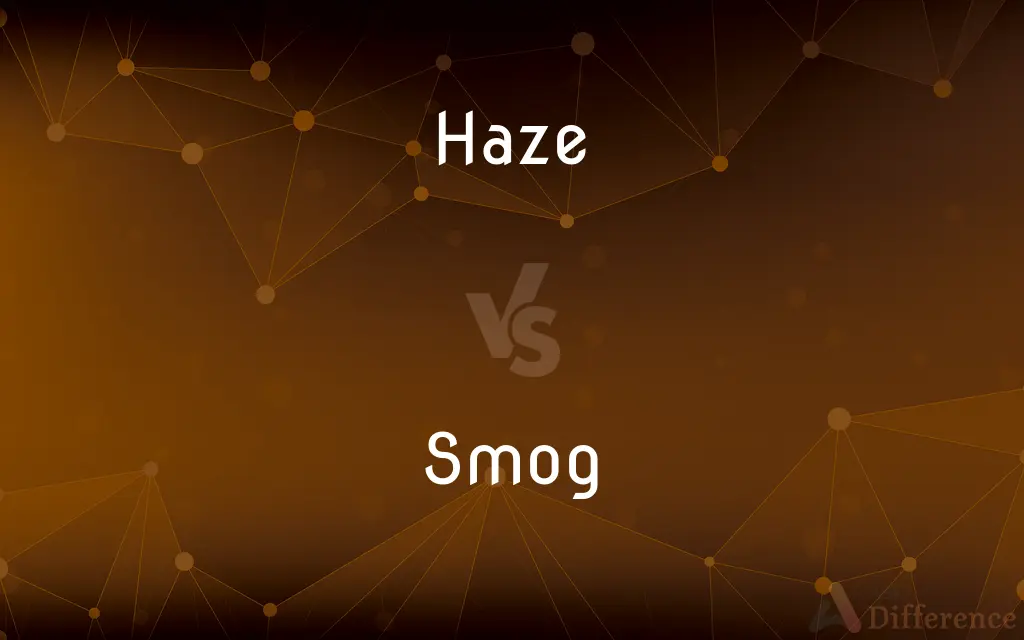Haze vs. Smog — What's the Difference?
By Urooj Arif & Fiza Rafique — Updated on March 14, 2024
Haze is a suspension of fine particles in the air, reducing visibility, often natural or pollutant-based, while smog is air pollution combining smoke and fog, typically from industrial or vehicular emissions.

Difference Between Haze and Smog
Table of Contents
ADVERTISEMENT
Key Differences
Haze occurs when dust, smoke, and other dry particles obscure the clarity of the sky, often resulting from both natural events, like wildfires or volcanic eruptions, and human activities, such as burning fossil fuels. Smog, a type of severe air pollution, is a mix of smoke, chemicals, and fog, originally describing the combination of smoke and fog in urban areas during the Industrial Revolution. Modern smog, or "photochemical smog," is mainly formed by the reaction of sunlight with pollutants emitted by vehicles, industrial processes, and gasoline vapors.
While haze can reduce visibility, affecting respiratory health, and contribute to environmental degradation, it does not always stem from pollutants harmful to health. Smog, on the other hand, specifically refers to polluted air that poses significant health risks, including respiratory problems, heart disease, and worsening of asthma conditions. It also has detrimental effects on the environment, damaging crops, forests, and aquatic systems.
The occurrence of haze can be seasonal, linked to agricultural practices, or weather conditions, whereas smog is more closely associated with urban and industrial activities, becoming more prevalent with increased pollution levels. Haze might appear in both rural and urban areas, but smog is predominantly an urban phenomenon, exacerbated by weather patterns and geography that trap pollutants over cities.
Management and mitigation of haze involve controlling sources of particulates, like reducing deforestation and managing agricultural fires. Combatting smog requires comprehensive air quality management, including emissions reductions from vehicles and industries, and the use of cleaner energy sources. Both phenomena highlight the need for environmental policies and individual actions aimed at reducing air pollution and protecting public health.
Comparison Chart
Definition
Suspension of fine particles in the air, reducing visibility
Air pollution combining smoke and fog
ADVERTISEMENT
Causes
Natural events and human activities
Industrial and vehicular emissions, chemical reactions
Health Effects
Can affect respiratory health, varies with particle source
Significant health risks, including respiratory issues
Environmental Impact
Affects visibility, can contribute to environmental degradation
Damages crops, forests, aquatic systems
Occurrence
Seasonal, linked to agricultural practices or weather
Associated with urban and industrial activities
Management
Controlling particulate sources
Emissions reductions, cleaner energy sources
Compare with Definitions
Haze
Atmospheric condition with reduced visibility due to particulates.
The morning haze obscured the distant mountains.
Smog
A type of air pollution created by the interaction of sunlight with pollutants.
The city was smothered in smog during the heatwave.
Haze
Affects outdoor visibility and can impact air travel.
Heavy haze led to delays at the airport.
Smog
Characterized by a mixture of smoke, chemicals, and fog.
Early mornings in the industrial city are marked by dense smog.
Haze
Can be a sign of air quality issues, depending on its composition.
The industrial area is frequently enveloped in a haze from factories.
Smog
Primarily an urban phenomenon, exacerbated by vehicle emissions.
Traffic congestion significantly contributes to urban smog.
Haze
Often results from natural or anthropogenic particulate sources.
After the forest fire, the city was covered in a thick haze.
Smog
Requires comprehensive policy measures for its reduction.
Implementing stricter emissions standards has helped reduce smog.
Haze
Seasonal in many regions, associated with specific activities.
Post-harvest burning practices contribute to the seasonal haze.
Smog
Poses serious health risks, particularly to the respiratory system.
The increase in smog has led to higher rates of asthma.
Haze
Haze is traditionally an atmospheric phenomenon in which dust, smoke, and other dry particulates obscure the clarity of the sky. The World Meteorological Organization manual of codes includes a classification of horizontal obscuration into categories of fog, ice fog, steam fog, mist, haze, smoke, volcanic ash, dust, sand, and snow.
Smog
Smoke fog, or smog for short, is a type of intense air pollution. The word "smog" was coined in the early 20th century, and is a contraction (portmanteau) of the words smoke and fog to refer to smoky fog due to its opacity, and odor.
Haze
A slight obscuration of the lower atmosphere, typically caused by fine suspended particles
The cold air has no pollution and very little haze
There was a thick haze on this October morning
Smog
Fog that has become mixed and polluted with smoke.
Haze
A state of mental confusion
An alcoholic haze
Smog
A form of air pollution produced by the photochemical reaction of sunlight with hydrocarbons and nitrogen oxides that have been released into the atmosphere, especially by automotive emissions.
Haze
Obscure with a haze
A clump of islands, very green, but hazed in cloud and mist
Smog
A noxious mixture of particulates and gases that is the result of urban air pollution.
Haze
Force (a new or potential recruit to the military or a university fraternity) to perform strenuous, humiliating, or dangerous tasks
Rookies were mercilessly hazed
Smog
(informal) To get a smog check; to check a vehicle or have it checked for emissions.
If the car is more than five years old, you'll have to have it smogged before you can register it.
Haze
Drive (cattle) while on horseback
He hazed them on and they clambered up through the rocks
Smog
Air pollution by a mixture of smoke and fog
Haze
Atmospheric moisture, dust, smoke, and vapor that diminishes visibility.
Haze
A partially opaque covering
Let the polish dry to a haze before buffing it.
Haze
A vague or confused state of mind.
Haze
To become misty or hazy; blur.
Haze
To persecute or harass with meaningless, difficult, or humiliating tasks.
Haze
To initiate, as into a college fraternity, by exacting humiliating performances from or playing rough practical jokes upon.
Haze
Very fine solid particles (smoke, dust) or liquid droplets (moisture) suspended in the air, slightly limiting visibility. fog, mist.}}
Haze
A reduction of transparency of a clear gas or liquid.
Haze
An analogous dullness on a surface that is ideally highly reflective or transparent.
The soap left a persistent haze on the drinking glasses.
The furniture has a haze, possibly from some kind of wax.
Haze
(figuratively) Any state suggestive of haze in the atmosphere, such as mental confusion or vagueness of memory.
Haze
The degree of cloudiness or turbidity in a clear glass or plastic, measured in percent.
Haze
Any substance causing turbidity in beer or wine.
Haze
To be or become hazy, or thick with haze.
Haze
To perform an unpleasant initiation ritual upon a usually non-consenting individual, especially freshmen to a closed community such as a college fraternity or military unit.
Haze
To oppress or harass by forcing to do hard and unnecessary work.
Haze
(transitive) In a rodeo, to assist the bulldogger by keeping (the steer) running in a straight line.
Haze
(transitive) To use aversive stimuli on (a wild animal, such as a bear) to encourage it to keep its distance from humans.
Haze
Light vapor or smoke in the air which more or less impedes vision, with little or no dampness; a lack of transparency in the air; hence, figuratively, obscurity; dimness.
O'er the skyThe silvery haze of summer drawn.
Above the world's uncertain haze.
Haze
A state of confusion, uncertainty, or vagueness of thought or perception; as, after the explosion, people were wandering around in a haze.
Haze
To be hazy, or thick with haze.
Haze
To harass by exacting unnecessary, disagreeable, or difficult work.
Haze
To harass or annoy by playing abusive or shameful tricks upon; to humiliate by practical jokes; - used esp. of college students, as an initiation rite into a fraternity or other group; as, the sophomores hazed a freshman.
Haze
Atmospheric moisture or dust or smoke that causes reduced visibility
Haze
Confusion characterized by lack of clarity
Haze
Become hazy, dull, or cloudy
Haze
Harass by imposing humiliating or painful tasks, as in military institutions
Common Curiosities
Can haze be harmful to health like smog?
While haze can impact health, particularly respiratory health, depending on its composition, smog is generally more harmful due to its toxic chemical composition and denser concentration of pollutants.
How is visibility measured in cases of haze and smog?
Visibility is measured using instruments like transmissometers, which calculate the extent to which light is absorbed or scattered by particles in the air, providing data on the density of haze or smog.
Can wearing masks help protect against the effects of haze and smog?
Wearing masks, especially those designed to filter out fine particulate matter, can help protect the respiratory system from the harmful effects of both haze and smog.
How can the effects of haze and smog be mitigated?
Mitigation involves controlling the sources of air pollutants through policies that reduce emissions from vehicles, industries, and agricultural practices, alongside promoting cleaner energy sources.
Why is smog more common in urban areas?
Smog formation is driven by a high concentration of emissions from vehicles and industries, which are more prevalent in urban settings, combined with sunlight to trigger chemical reactions.
How do weather conditions affect haze and smog?
Weather conditions, like wind and rain, can disperse or wash away pollutants, reducing haze and smog. Conversely, stable, dry conditions can exacerbate both phenomena by allowing pollutants to accumulate.
What are the main differences between haze and smog?
Haze is a general reduction in visibility due to particulates in the air, which can be natural or pollutant-based, while smog specifically refers to polluted air resulting from industrial or vehicular emissions and poses greater health risks.
Are there specific seasons for the occurrence of haze and smog?
Haze can be seasonal, often associated with dry weather conditions or agricultural burning practices, whereas smog can occur year-round but may worsen in warmer months due to increased sunlight driving photochemical reactions.
What is the difference between photochemical smog and traditional smog?
Traditional smog, or "gray smog," results from smoke and fog in cool, humid conditions. Photochemical smog, or "summer smog," forms when sunlight reacts with pollutants like nitrogen oxides and volatile organic compounds, leading to a more harmful mixture.
What role do individuals play in reducing haze and smog?
Individuals can contribute by reducing their carbon footprint, using public transportation, supporting clean energy initiatives, and advocating for environmental policies aimed at improving air quality.
Share Your Discovery

Previous Comparison
Capability vs. Function
Next Comparison
Final vs. FinalsAuthor Spotlight
Written by
Urooj ArifUrooj is a skilled content writer at Ask Difference, known for her exceptional ability to simplify complex topics into engaging and informative content. With a passion for research and a flair for clear, concise writing, she consistently delivers articles that resonate with our diverse audience.
Co-written by
Fiza RafiqueFiza Rafique is a skilled content writer at AskDifference.com, where she meticulously refines and enhances written pieces. Drawing from her vast editorial expertise, Fiza ensures clarity, accuracy, and precision in every article. Passionate about language, she continually seeks to elevate the quality of content for readers worldwide.













































